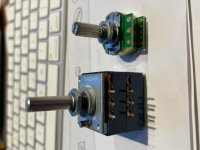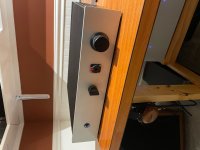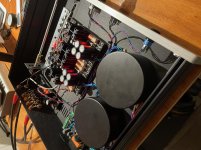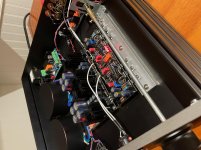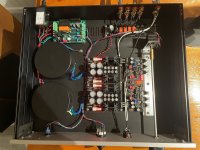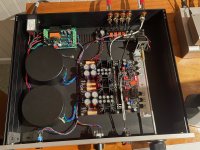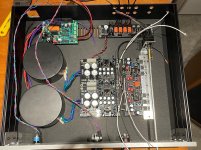I see. I was looking at the first seven pages of the data sheet (up to Absolute Maximum Ratings) and there's no indication that I can see that the -2 is a dual version until later in the document. The specs for the -1 are better so I assumed the suffix just referred to the chip grade. I thought possibly you were working on a one-channel-per-board variation of the DCG3.
The AD823 is in plentiful supply, so I guess you are looking to experiment with different servo amps.
The AD823 is in plentiful supply, so I guess you are looking to experiment with different servo amps.
I think I paid about $12 each for ADA4625-2, its DC performance is very good but there are likely better devices for this use, and it may not be stable in this application either, need to check carefully for oscillation. .
I think I paid about $12 each for ADA4625-2, its DC performance is very good but there are likely better devices for this use, and it may not be stable in this application either, need to check carefully for oscillation.
The ADA4625-2 is supposed to be unity-gain stable so oscillation shouldn't be a problem, I would think.
For my latest project, I selected ADA4627-1. It is also unity-gain stable. It has much better offset and input bias current specs than ADA4625-1, but worse noise specs. It's quieter than the AD823 across the audio band, but comparable below 100Hz. It should be no worse than the AD823 in the DCG3, which is already dead quiet.
I believe the resistors in the servo circuit will be larger sources of noise than the op-amps themselves, when using low-noise op-amps.
Unfortunately, there is no dual version of the ADA4627. There are a lot of op-amps out there that you can use, but if you're intent on chasing the secret sauce, I guess getting just the right part is important.
Choosing between unity gain stable very low input bias current op-amps like JFET and CMOS because of the high source impedance low pass input filter in the servo circuit.
U1 servo subjectively affects to an extent. ADA4625-2 promoting even more resolution, AD823 a warmer tonal balance still with very good resolution.
OPA1642 OPA2156 OPA1656 have been tested too. Those tend to ADA4625-2 effect.
U1 servo subjectively affects to an extent. ADA4625-2 promoting even more resolution, AD823 a warmer tonal balance still with very good resolution.
OPA1642 OPA2156 OPA1656 have been tested too. Those tend to ADA4625-2 effect.
No, DC servos are inherently low noise as they are RC low pass filters.I believe the resistors in the servo circuit will be larger sources of noise than the op-amps themselves, when using low-noise op-amps.
Consider a 220nF and 1M dc servo circuit. It has a roll-off at 0.7Hz, so the 1M resistor noise of 130nV/√Hz below 0.7Hz is divided down to 4.6nV/√Hz at 20Hz, and 0.91nV/√Hz by 100Hz. (Basically irrelevant above 50Hz or so).
You can also use the capacitor noise formula to determine the total rms noise for a 220nF cap across a resistor is sqrt (kT/C) = 0.14µV rms. A 5nV/√Hz opamp contributes at least 0.7µVrms across the audio band for comparison (ignoring any flicker noise)
Last edited:
No, DC servos are inherently low noise as they are RC low pass filters.
I agree. I was thinking more of the 10K resistors on the output of the servo, which don't have the benefit of low-pass filtering. This website I have here says thermal noise for a 10K resistor is 12.8318 nV/√Hz.
On the other hand, the noise on the servo output is attenuated because the 10K resistor feeds a 499 Ohm feedback resistor.
In reality, the noise levels are very low regardless -- unless you're trying to win a gold star at Audio Science Review. 🙄
The DC servo output is in parallel with the source resistance, which is generally much lower and determines the noise floor.
The DC servo output is in parallel with the source resistance, which is generally much lower and determines the noise floor.
I don't feel like getting in a pedantic EE *******, sorry, I meant "micturating," match. I was simply noting that a 10K resistor generates more thermal noise than many low-noise op-amps. Then, on second thought, that it doesn't matter because the resistor is a poor match to the impedance at the inverting input of the amplifier.
I truly hope no further elaboration is required.
Question about using POTs.. 🙂
I'm planning to compare an Alps 20k (I know it's not supposed to be the best in this application) and China/Ebay 20k smd version. I'll be remote locating the pots from the inselect board and using an extention rod..
Anyway, few questions.. Anyone used this specific Chinese pot? It's labeled A20K on the back.. Secondly, as far as connecting it to the inselect board I'm assuming that the terminal locations on the Chinese pot are not corresponding with similarly placed terminals on the Alps? Curious if anyone has sorted that out?
Thanks all for the wealth of info.. I'm hoping at some point someone will ask a question that I actually know the answer to! 🙂
Cheers!
I'm planning to compare an Alps 20k (I know it's not supposed to be the best in this application) and China/Ebay 20k smd version. I'll be remote locating the pots from the inselect board and using an extention rod..
Anyway, few questions.. Anyone used this specific Chinese pot? It's labeled A20K on the back.. Secondly, as far as connecting it to the inselect board I'm assuming that the terminal locations on the Chinese pot are not corresponding with similarly placed terminals on the Alps? Curious if anyone has sorted that out?
Thanks all for the wealth of info.. I'm hoping at some point someone will ask a question that I actually know the answer to! 🙂
Cheers!
Attachments
Anyway, few questions.. Anyone used this specific Chinese pot?
I had tested that one in DCG3. Not vs an ALPS Blue but vs a TKD and a Goldpoint. I think its well clean and focused but bit treble pinched and not giving a very secure mechanical feel of course.
Its terminals order is conventional, normal.
I had tested that one in DCG3. Not vs an ALPS Blue but vs a TKD and a Goldpoint. I think its well clean and focused but bit treble pinched and not giving a very secure mechanical feel of course.
Its terminals order is conventional, normal.
Awesome.. Salas, which POT wound up being your favorite between the three?
The Goldpoint for its channels matching precision being a switcher but without harshness. Its expensive even at 24 steps though. This number of steps can be bit coarse if with efficient loudspeakers and a highish voltage gain spec power amp. At 47 steps its a very expensive pot.
The TKD although clean has some character, a more fleshed out but smooth portrayal. Reminds of classic audio tone like Sansui. Its also continuous being a track pot. No gaps. If without enough voltage gain in the chain you can even say its taper opens up rather late on the clock.
The TKD although clean has some character, a more fleshed out but smooth portrayal. Reminds of classic audio tone like Sansui. Its also continuous being a track pot. No gaps. If without enough voltage gain in the chain you can even say its taper opens up rather late on the clock.
The Goldpoint for its channels matching precision being a switcher but without harshness. Its expensive even at 24 steps though. This number of steps can be bit coarse if with efficient loudspeakers and a highish voltage gain spec power amp. At 47 steps its a very expensive pot.
The TKD although clean has some character, a more fleshed out but smooth portrayal. Reminds of classic audio tone like Sansui. Its also continuous being a track pot. No gaps. If without enough voltage gain in the chain you can even say its taper opens up rather late on the clock.
Thank you for the input.. I may grab a TKD 20k as well and see if I can tell the difference.. My speakers (Hersey's/Modded) are pretty efficient so the 24 step Goldpoint may not be a great option.. And I'm probably to cheap to pony up for the 47step version!
Salas..
Typo.. Yessir.. They are very 30 year old Klipsch Heresy I's. I've done some crossover mods and upgraded the woofer.. Mod called the "Super Heresy".. I'll take a hard look at the TKD pot.. I looked a few months back when I started all of this and I think I need to order from across the pond.. Thanks for the rec!
Typo.. Yessir.. They are very 30 year old Klipsch Heresy I's. I've done some crossover mods and upgraded the woofer.. Mod called the "Super Heresy".. I'll take a hard look at the TKD pot.. I looked a few months back when I started all of this and I think I need to order from across the pond.. Thanks for the rec!
DCG3 all finished!
Another DCG3 is born!
Finished up my DCG3 this weekend and couldn't be happier with it. Fairly generic build although I added Mark Johnson's power board. Thank you to Salas, pFarrell, Tea-Bag, and many others for your assistance in answering all of my questions. This is only the second 'pre' that I have any experience with, the first being the Whammy. The sound is simply fabulous. It's dead quiet via headphones and when paired with my Aleph J, it is slightly more quiet (It was pretty damn quiet before) than with the Whammy.. (No disrespect.. Love my whammy, and I'll be moving it to another location in the house to use)..
Surprisingly, my Fostex X-00's sound like different headphones.. Much more bass and fuller sound.. Very pleased with them and will probably spend more time listening to music via phones..
Another DCG3 is born!
Finished up my DCG3 this weekend and couldn't be happier with it. Fairly generic build although I added Mark Johnson's power board. Thank you to Salas, pFarrell, Tea-Bag, and many others for your assistance in answering all of my questions. This is only the second 'pre' that I have any experience with, the first being the Whammy. The sound is simply fabulous. It's dead quiet via headphones and when paired with my Aleph J, it is slightly more quiet (It was pretty damn quiet before) than with the Whammy.. (No disrespect.. Love my whammy, and I'll be moving it to another location in the house to use)..
Surprisingly, my Fostex X-00's sound like different headphones.. Much more bass and fuller sound.. Very pleased with them and will probably spend more time listening to music via phones..
Attachments
By the way, are those photos from a test phase when you used a mono input? Because I see only one input coax and a jumper (?) red-green twisted pair to the other channel's input. On the main dcg3 board.
Thank you Salas, for the kind words, and for all of your tech support!
Regarding the inputs.. Good eye.. Maybe I didn't make the connection properly? I used 3 wire mic cable (2 signal + Drain) from the inselect board.. Left channel and GND connected to left side, right channel crosses over and is twisted with a ground jumper.. Right signal (Red) is connected to Right IN and the two grounds are jumpered with the green wire. After our chat about the grounds all being on a common bus, I'm not sure I needed that jumper wire..
If I've wired it incorrectly, it still sounds great! Lol..
Regarding the inputs.. Good eye.. Maybe I didn't make the connection properly? I used 3 wire mic cable (2 signal + Drain) from the inselect board.. Left channel and GND connected to left side, right channel crosses over and is twisted with a ground jumper.. Right signal (Red) is connected to Right IN and the two grounds are jumpered with the green wire. After our chat about the grounds all being on a common bus, I'm not sure I needed that jumper wire..
If I've wired it incorrectly, it still sounds great! Lol..
Attachments
Last edited:
- Home
- Source & Line
- Analog Line Level
- Salas DCG3 preamp (line & headphone)
